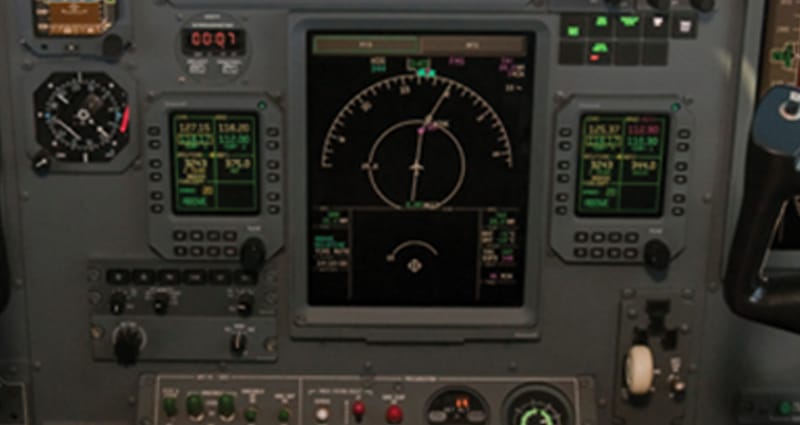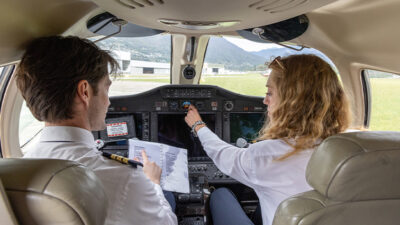Promoting Safety Communication Within the Aviation Department

Whether it is to get the passengers to their destination on time, return an aircraft to service before its next scheduled flight or put together a complicated 5-day trip, our focus is on getting the job done.
Sure, we’re told that we have to do that safely, but we’re here to satisfy the company’s travel demands. These should not be viewed as exclusive priorities, but rather closely coordinated ones.
When safety and operational requirements are properly balanced and integrated, the aviation department is positioned to provide the best overall service. A Safety Management System (SMS) creates and maintains this integration and balance. An SMS is built around four primary components:
1) safety policy and objectives;
2) a risk management process;
3) safety assurance; and
4) safety promotion.
This article will focus on the fourth component: promoting safety as a frequent topic of supreme importance and relevance to all stakeholders. Every employee should hear, consistently and repeatedly, that safety concerns carry as much weight as the need to complete the assigned task on time. The highest level of communication in this regard comes from two sources outside the aviation department. Nothing has a more adverse impact on a department’s safety commitment than a senior official that expresses dissatisfaction over a diverted, delayed or cancelled flight. That such things happen infrequently is testament to the professionalism of the personnel who are able to complete some assignments even in the face of difficult circumstances.
The accountable executive holds overall responsibility for the aviation department, including its performance with respect to safety objectives. The accountable executive should make clear in public statements, both written and oral, that safety holds a high priority in the department’s performance expectations. The company’s commitment to safety should be made clear to those who would travel on the company’s aircraft as well as to those who operate them.
The other outside influence comes from the passengers themselves. Passengers must understand and appreciate that, just as with the airlines, adjustments are made for their safety. A simple acknowledgment of that understanding reinforces to the crew that they made the right decision.
Internal to the department, safety communication comes in several forms. Heard on an almost daily basis is the question, “Can we do it safely?” This may be asked verbally by a supervisor or another crew member. It is also inherent in the use of the risk assessment process, policy waiver procedures and change management. These tools should be seen not as another form to fill out and go on with the job, but as a way to answer the question, “Can we do it safely?” If the risk is marginal, what mitigation steps can we take to make the risk as low as reasonably practicable?
The safety reporting form (some refer to it as Hazard Identification and Tracking System) promotes communication within the department. It encourages discussion and information exchange (“That also happened to me at the same airport!”). The reported incident may be reviewed by the Safety Committee and could lead to a change in policy or procedure based on consensus input. Even while the report is being investigated by the Safety Committee or others, sharing it with all members of the department promotes communication and could lead to deeper insight into the issue.
The department’s formal communications processes also serve an important role in keeping people informed. A Read and Initial file, distribution of changes in the department’s manuals, bulletin boards, scheduled staff meetings and other means all are used to ensure that everyone is kept informed of new policies or procedures. Even informal conversations, email, aviation blogs or web portals are all effective. Each of these offers opportunities to reinforce the company’s emphasis on safety as part of every employee’s job responsibility.
Communication flows up as well as it does down. Every employee should feel completely safe in expressing concern on safety matters without fear of retribution from supervisors. Errors in judgment, errors of commission and errors of omission should be openly admitted with the understanding that everyone can learn from the mistakes of others. The department that adheres to a “just culture” encourages open communication and takes advantage of teaching moments.
Transparency is a critical characteristic of the company’s approach to safety management. Personnel should share a common understanding of the company’s safety objectives, support each other in living up to high standards, monitor performance of others as well as themselves and point out situations that present opportunities for improvement. Ideally, all of the safety communication options mentioned above are accessible to all employees.
Earlier I referred to the accountable executive’s message to employees about his or her support of the Safety Management System. The SMS can inform and support top management’s reliance on the aviation department. Typically, the aviation manager makes periodic reports to management on the state of the department—number of trips, passenger use, budget, etc. Those reports can also include data gathered by the SMS—issues faced in flight planning, crew duty time and rest concerns, maintenance issues, etc. This kind of communication engages upper management in discussions related to safety. It also showcases the processes the department uses to meet those challenges and still deliver outstanding service.
As aviators, sometimes our biggest challenge is balancing operational priorities and safety priorities. Consistent and effective communication allows everyone involved to understand how that balance can be upset, and what needs to be done to set it right. Communication is the foundation of the safety promotion aspect of an effective SMS. If you have questions about safety promotion or any other part of SMS, don’t hesitate to drop us a note or give us a call.

Customized Safety Management programs developed by experienced and credentialed safety professionals include training, manual management and SMS implementation/software. Based on ICAO and other international standards and regulations, Baldwin’s programs support Business Aviation, Charter, FBO, Airport, Medical Transport and Regional Airlines by providing advanced software, an outstanding customer experience and our Commitment to Excellence.
http://www.baldwinaviation.com/
© 2024 Baldwin Safety & Compliance. All Rights Reserved.
Next ArticleRelated Posts

The Art of Influence Has Never Been More Important—or More Overlooked
As our industry continues to grind through the growth pains of a generational handoff, the art of peer-to-peer influence has never been more critical. While executive leadership is important, attitudes, values and culture are shaped informally by experienced line employees and first-line supervisors operating far, far away from the C-suites.

Safety in Numbers: Trends in Aviation Accidents and Incidents
Every accident is preventable; the problem is that we don’t know how to prevent it until after the accident happens. However, what we can do as an industry is honor the anguish of each event by sharing the information, the mistakes and the outcomes to improve safety for everyone.

